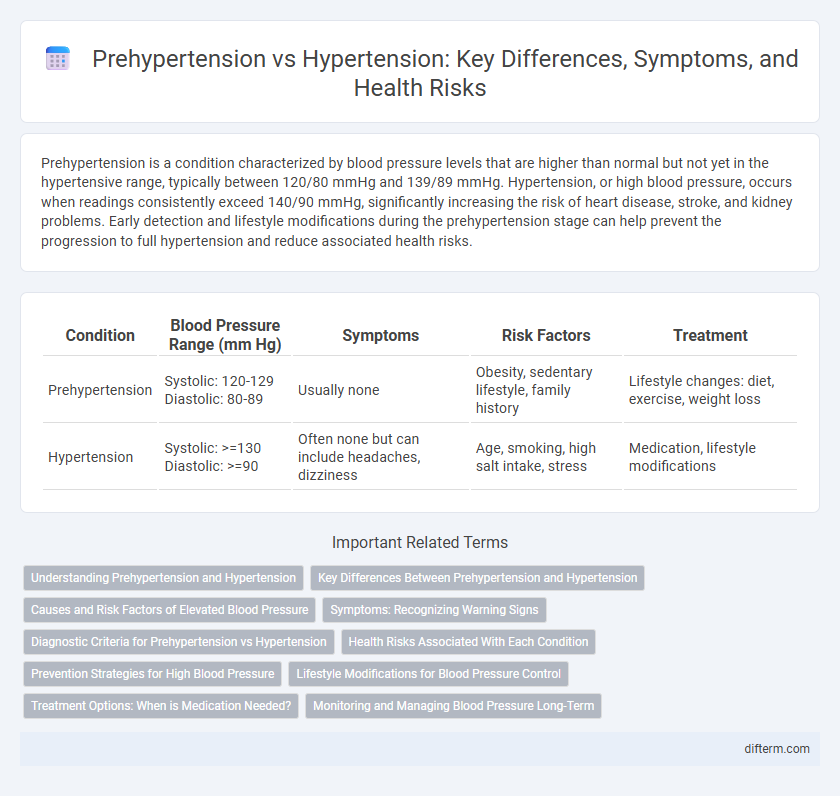Prehypertension is a condition characterized by blood pressure levels that are higher than normal but not yet in the hypertensive range, typically between 120/80 mmHg and 139/89 mmHg. Hypertension, or high blood pressure, occurs when readings consistently exceed 140/90 mmHg, significantly increasing the risk of heart disease, stroke, and kidney problems. Early detection and lifestyle modifications during the prehypertension stage can help prevent the progression to full hypertension and reduce associated health risks.
Table of Comparison
| Condition | Blood Pressure Range (mm Hg) | Symptoms | Risk Factors | Treatment |
|---|---|---|---|---|
| Prehypertension | Systolic: 120-129 Diastolic: 80-89 |
Usually none | Obesity, sedentary lifestyle, family history | Lifestyle changes: diet, exercise, weight loss |
| Hypertension | Systolic: >=130 Diastolic: >=90 |
Often none but can include headaches, dizziness | Age, smoking, high salt intake, stress | Medication, lifestyle modifications |
Understanding Prehypertension and Hypertension
Prehypertension is defined by systolic blood pressure levels between 120-139 mm Hg and diastolic levels between 80-89 mm Hg, indicating an elevated risk for developing hypertension. Hypertension, classified as systolic pressure above 140 mm Hg or diastolic pressure above 90 mm Hg, significantly increases the risk of cardiovascular diseases, including heart attack and stroke. Early identification and lifestyle interventions in the prehypertensive stage can prevent progression to hypertension and reduce associated health complications.
Key Differences Between Prehypertension and Hypertension
Prehypertension is characterized by systolic blood pressure between 120-139 mm Hg and diastolic pressure between 80-89 mm Hg, serving as an early warning sign for cardiovascular risk, whereas hypertension is defined by systolic pressure of 140 mm Hg or higher or diastolic pressure of 90 mm Hg or higher, indicating sustained high blood pressure. Prehypertension often requires lifestyle modifications such as diet and exercise to prevent progression, while hypertension commonly necessitates antihypertensive medication management. Monitoring blood pressure regularly is crucial for distinguishing between these stages and reducing risks of heart disease, stroke, and kidney damage.
Causes and Risk Factors of Elevated Blood Pressure
Prehypertension and hypertension both result from increased vascular resistance and impaired arterial function, often triggered by factors such as obesity, sedentary lifestyle, excessive sodium intake, and chronic stress. Genetic predisposition, age-related arterial stiffness, and underlying conditions like diabetes and kidney disease significantly contribute to elevated blood pressure levels. Identifying and managing these risk factors early is crucial to prevent progression from prehypertension to full-blown hypertension and associated cardiovascular complications.
Symptoms: Recognizing Warning Signs
Prehypertension often presents with subtle or no obvious symptoms, making regular blood pressure monitoring essential for early detection. Hypertension symptoms may include persistent headaches, dizziness, blurred vision, and chest pain, signaling increased cardiovascular risk. Recognizing these warning signs early allows timely medical intervention to prevent complications such as stroke, heart attack, and kidney damage.
Diagnostic Criteria for Prehypertension vs Hypertension
Prehypertension is diagnosed when systolic blood pressure ranges from 120 to 139 mm Hg or diastolic pressure ranges from 80 to 89 mm Hg, indicating elevated risk without meeting hypertension thresholds. Hypertension diagnosis requires systolic readings of 140 mm Hg or higher or diastolic readings of 90 mm Hg or higher, confirmed by multiple measurements over time. Accurate classification is vital for early intervention and management to prevent cardiovascular complications.
Health Risks Associated With Each Condition
Prehypertension, characterized by blood pressure readings between 120-139/80-89 mmHg, increases the risk of developing hypertension and cardiovascular complications over time. Hypertension, defined by readings of 140/90 mmHg or higher, significantly elevates the likelihood of heart attack, stroke, kidney disease, and other serious health problems. Both conditions demand lifestyle modifications and medical monitoring to reduce long-term health risks effectively.
Prevention Strategies for High Blood Pressure
Effective prevention strategies for high blood pressure focus on lifestyle modifications such as maintaining a balanced diet rich in potassium and low in sodium, regular physical activity of at least 150 minutes per week, and weight management to reduce cardiovascular risk. Monitoring blood pressure regularly allows early identification of prehypertension, enabling timely intervention through stress reduction techniques and limiting alcohol consumption. Adopting these preventive measures can significantly lower the progression from prehypertension to hypertension and decrease the risk of associated complications like stroke and heart disease.
Lifestyle Modifications for Blood Pressure Control
Lifestyle modifications including a low-sodium diet, regular physical activity, and weight management play a crucial role in controlling prehypertension and preventing progression to hypertension. Reducing alcohol intake and managing stress through techniques such as meditation or yoga further aid in lowering blood pressure. Consistent adherence to these changes can significantly improve cardiovascular health and reduce the risk of complications associated with high blood pressure.
Treatment Options: When is Medication Needed?
Prehypertension treatment primarily involves lifestyle modifications such as dietary changes, increased physical activity, and weight management to prevent progression to hypertension. Medication is generally recommended when blood pressure consistently exceeds 130/80 mmHg or when patients have additional cardiovascular risk factors like diabetes or chronic kidney disease. Early intervention with antihypertensive drugs helps reduce the risk of heart attack, stroke, and other complications associated with sustained high blood pressure.
Monitoring and Managing Blood Pressure Long-Term
Consistent monitoring of blood pressure is crucial for distinguishing between prehypertension and hypertension and preventing complications. Utilizing home blood pressure monitors and maintaining regular check-ups with healthcare providers ensures timely adjustments in lifestyle or medication. Long-term management includes adopting a balanced diet, regular physical activity, stress reduction techniques, and adherence to prescribed antihypertensive treatments.
prehypertension vs hypertension Infographic

 difterm.com
difterm.com